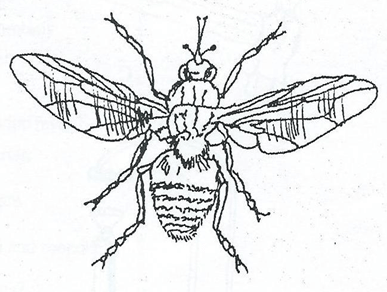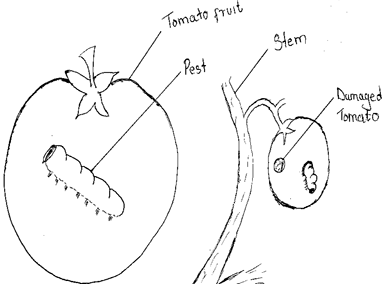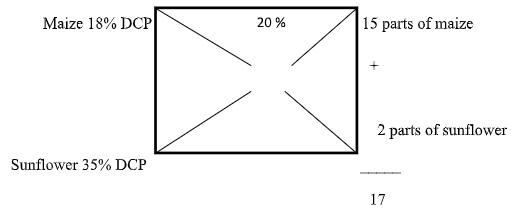INSTRUCTIONS TO STUDENTS
- Answer ALL the questions in the spaces provided
- Differentiate between under-sowing and over-sowing (1mk)
- Name four methods of farming (2mks)
- State four categories of vegetables. (2 mks )
- List four human factors that influence agriculture (2mks)
- Give four reasons for treating water for use on the farm (2mks)
- State the function of the following parts in digestive system of poultry (1½ mks)
- Crop………………………………………………………………………………
- Gizzard…………………………………………………………………………
- Caecum ……………………………………………………………………………
- State four precautions that should be observed when using workshop tools (2mks)
- Give four reasons why burning is discouraged as a method of land clearing (2mks)
- Name four practices that enhance minimum tillage (2mks)
- Give three sources of underground water (1½)
- State four characteristics of a fertile soil (2mks)
- Name four breeds of dairy goats (2mks)
- Name two types of Inventory records (1mk)
- List four symptoms of Nitrogen deficiency in plants (2mks)
- Name two vegetative materials used to propagate pineapples (1mk)
- Outline four factors considered when selecting a nursery site (2mks)
- State four characteristics of a good grain store (2mks)
- The following is a list of plant nutrients; copper, calcium, nitrogen, zinc, molybdenum, phosphorus, carbon, sulphur, iron and magnesium.
Which of the above nutrients are?- Macro elements (2mks)
- Micro elements (1mk)
- Fertilizer elements (1mk)
- Liming elements (1mk)
- The diagram below illustrates a livestock parasite

- Identify the parasite illustrated above (1mk)
- State the major harmful effect of the parasite (1mk)
- Explain three control measures of the parasite (3mk)
- The diagram below is an illustration a tomato crop pest. Study it and answer the question that follows.
- Identify the pest. (1mark)
- How can a farmer control the pest named in (a) above. (1 mark)
- Name other three minor tomato pest. (3 marks)
-
- State the importance of vegetables to a farmer (5mks)
- Briefly describe the production of onions under the following sub-headings
- Varieties (1mk)
- Ecological requirements (3mks)
-
- Define the following terms as used in livestock health (2mks)
- Disease
- Health
- Differentiate between digestion in ruminant and non-ruminants(5mks)
- A farmer wanted to prepare 200kg of calf rearing ration containing 20 % DCP, using the person’s square method calculate the amount of maize containing 18% DCP and sunflower containing 35% DCP the framer would need to prepare. (4mks show your working)
- Define the following terms as used in livestock health (2mks)
- Describe 5 factors to consider when selecting nursery site (5mks)

MARKING SCHEME
- Differentiate between under-sowing and over-sowing (1mk)
- Under-sowing is the establishment of pasture under a cover crop, usually maize.
- Over-sowing is the establishment of pasture legume such as desmodium in existing grass pasture.
- Name four methods of farming (2mks)
- Mixed farming
- Nomadic pastoralism
- Shifting cultivation
- Organic farming
- agroforestry
- State four categories of vegetables (2 mks)
- Stem vegetables
- Root vegetable
- Fruit vegetables
- Pod vegetable
- Leaf vegetable
- Bulb vegetable
- List four human factors that influence agriculture (2mks)
- Level of education and technology
- Health
- Economy
- Government policy
- Cultural practices and religious beliefs
- Market forces
- Give four reasons for treating water for use on the farm (2mks)
- To kill disease micro-organisms
- To remove chemical impurities
- To remove bad smell and taste
- To remove sediments of solid particles
- State the function of the following parts in digestive system of poultry (11/2 mks)
- Crop store food temporarily and moisten it with water
- Gizzard grind and crush food into a paste
- Caecum digest cellulose, absorb water and by-products of microbial digestion
- State four precautions that should be observed when using workshop tools (2mks)
- Tools should always be left in safe place after use
- Use correct tool for correct job
- Tools should be handled correctly when in use to avoid damage to the tool and injury to the user
- Use of safety devices such as fire extinguishers and first aid kits in workshop to reduce accidents
- All tools should be kept properly in tool cabinets/racks
- Tools should be maintained and serviced to remain in good working condition
- Give four reasons why burning is discouraged as a method of land clearing (2mks)
- A lot of organic matter are destroyed
- Soil micro-organisms are destroyed
- Plant nutrients are destroyed
- Can spread to unintended areas
- Name four practices that enhance minimum tillage (2mks)
- Use of herbicides to control weeds
- Use of mulch
- Timing cultivation
- Restricting cultivation to the area where seeds are to be planted
- Cover cropping
- Uprooting /slashing weeds on perennial crops
- Give three sources of underground water (11/2)
- Springs
- Boreholes
- wells
- State four characteristics of a fertile soil (2mks)
- Correct Ph
- proper drained
- Good water holding capacity
- Good depth
- Adequate nutrient supply
- Free from excessive infestation of soil borne pest and diseases
- Name four breeds of dairy goats (2mks)
- Saanen
- Aglo-nubian
- British alpine
- Toggenberg
- jamnapari
- Name two types of Inventory records (1mk)
- Consumable goods inventory
- Permanent goods
- List four symptoms of Nitrogen deficiency in plants (2mks)
- Chlorosis
- Leaf turns brown and fall off prematurely
- Stunted growth
- Leaves turn purplish in colour (anthocyanin)
- Name two vegetative materials used to propagate pineapples (1mk)
- Crown and slip
- suckers
- Outline four factors considered when selecting a nursery site (2mks)
- Topography
- Nearness to water source
- Type of soil
- Previous cropping
- Security
- Well sheltered place
- State four characteristics of a good grain store (2mks)
- Rat and vermin proof
- Well ventilated
- Easy to load and offload
- Pest free
- Leak proof
- Well secured
- Cool conditions to prevent over heating that would crack the grains
- The following is a list of plant nutrients; copper, calcium, nitrogen, zinc, molybdenum, phosphorus, carbon, sulphur, iron and magnesium. Which of the above nutrients are?
- Macro elements: Nitrogen, phosphorus, carbon, magnesium, sulphur, calcium (2mks)
- Micro elements: molybdenum, iron, copper, zinc (1mk)
- Fertilizer elements: nitrogen, phosphorus (1mk)
- Liming elements: calcium, magnesium and sulphur (1mk)
- The diagram below illustrates a livestock parasite
- identify the parasite illustrated above (1mk)
- Tsetse fly
- state the major harmful effect of the parasite (1mk)
- transmit Trypanosomiasis
- explain three control measures of the parasite (3mk)
- bush clearing
- spraying their breeding sites with appropriate insecticide
- use of fly traps with impregnated nets
- use of sterilising agents
- bush clearing
- identify the parasite illustrated above (1mk)
- The diagram below is an illustration a tomato crop pest . Study it and answer the question that follow.
- Identify the pest. (1mark)
- American ballworm (Heliothis amigera)
- How can a farmer control the pest named in (a) above. (1 mark)
- By spraying the tomato with insecticides.
- Name other three minor tomato pest. (3 marks)
- Cutworm
- Red spider
- Mite
- nematode
- Identify the pest. (1mark)
-
- Explain the importance of vegetables to a farmer (5mks)
- Good complements for staple food
- Provide body with vitamins and minerals thus acting as protective food
- Parts of vegetables which are not used as human food may be fed to livestock or used to make manure
- Vegetables are sold in markets hence farmer earns income
- Briefly describe the production of onions under the following sub-headings
- Varieties (1mk)
- Red creole
- Tropicana hybrid
- White creole
- Ecological requirements (3mks)
- Hot and warm climate
- Altitude of 2100meters above sea level
- Fertile well drained soil
- Soil ph. 6-7
- 1000mm of rain per year
- Varieties (1mk)
- Explain the importance of vegetables to a farmer (5mks)
-
- Define the following terms as used in livestock health (2mks)
- Disease is any deviation/alteration in state of body of animal or its organs which interrupts proper performance of its function
- Health state in which all body organs/system are considered normal and are working normally
- Differentiate between digestion in ruminant and non-ruminants(5mks)
Ruminants Non-ruminants ✓Chew curd ✓Polygastric✓Regurgitate food✓Can digest cellulose✓No ptyalin in saliva hence no enzymatic digestion in mouth✓Most absorption take place in rumen✓Has alkaline saliva due presence of ammonia✓Don’t chew curd ✓ Monogastric✓Cannot regurgitate food✓Cannot digest cellulose except animals with microorganism in caecum✓Has ptyalin in saliva hence enzymatic digestion starts in mouth✓Most digestion and absorption take place in small intestines✓Saliva is neutral in ph. - A farmer wanted to prepare 200kg of calf rearing ration containing 20 % DCP, using the person’s square method calculate the amount of maize containing 18% DCP and sunflower containing 35% DCP the framer would need to prepare. (4 mks show your working)
15/17 x 200 = 176.47kg of maize
2/17 x 200 = 23.53kg of sunflower
- Define the following terms as used in livestock health (2mks)
- Describe 5 factors to consider when selecting a nursery site. (5mks)
- Nearness to water source
- Type of soil
- Topography
- Previous cropping
- Security
- Well sheltered place
Join our whatsapp group for latest updates
Tap Here to Download for 50/-
Get on WhatsApp for 50/-
Download Agriculture Questions and Answers - Form 3 Term 1 Opener Exams 2023.
Tap Here to Download for 50/-
Get on WhatsApp for 50/-
Why download?
- ✔ To read offline at any time.
- ✔ To Print at your convenience
- ✔ Share Easily with Friends / Students



